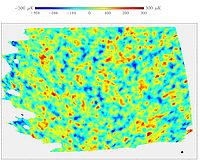
BOOMERanG experiment
Encyclopedia

Cosmic microwave background radiation
In cosmology, cosmic microwave background radiation is thermal radiation filling the observable universe almost uniformly....
of a part of the sky during three sub-orbital (high altitude
High altitude balloon
High-altitude balloons are unmanned balloons, usually filled with helium or hydrogen that are released into the stratosphere, generally reaching between ....
) balloon
Balloon
A balloon is an inflatable flexible bag filled with a gas, such as helium, hydrogen, nitrous oxide, oxygen, or air. Modern balloons can be made from materials such as rubber, latex, polychloroprene, or a nylon fabric, while some early balloons were made of dried animal bladders, such as the pig...
flights. It was the first experiment to make large, high fidelity images of the CMB temperature anisotropies. By using a telescope which flew at over 42,000 meters high, it was possible to reduce the atmospheric absorption of microwaves to a minimum. This allowed massive cost reduction compared to a satellite probe, though only a small part of the sky could be scanned.
The first was a test flight over North America
North America
North America is a continent wholly within the Northern Hemisphere and almost wholly within the Western Hemisphere. It is also considered a northern subcontinent of the Americas...
in 1997. In the two subsequent flights in 1998 and 2003 the balloon was launched from McMurdo Station
McMurdo Station
McMurdo Station is a U.S. Antarctic research center located on the southern tip of Ross Island, which is in the New Zealand-claimed Ross Dependency on the shore of McMurdo Sound in Antarctica. It is operated by the United States through the United States Antarctic Program, a branch of the National...
in the Antarctic. It was carried by the Polar vortex
Polar vortex
A polar vortex is a persistent, large-scale cyclone located near one or both of a planet's geographical poles. On Earth, the polar vortices are located in the middle and upper troposphere and the stratosphere...
winds in a circle around the South Pole
South Pole
The South Pole, also known as the Geographic South Pole or Terrestrial South Pole, is one of the two points where the Earth's axis of rotation intersects its surface. It is the southernmost point on the surface of the Earth and lies on the opposite side of the Earth from the North Pole...
, returning after two weeks. From this phenomenon the telescope took its name.
The BOOMERanG team was led by Andrew E. Lange
Andrew E. Lange
Andrew E. Lange was an astrophysicist and Goldberger Professor of Physics at the California Institute of Technology in Pasadena, California. Lange came to Caltech in 1993 and was most recently the chair of the Division of Physics, Mathematics and Astronomy...
of Caltech and Paolo de Bernardis of the
University of Rome La Sapienza
University of Rome La Sapienza
The Sapienza University of Rome, officially Sapienza – Università di Roma, formerly known as Università degli studi di Roma "La Sapienza", is a coeducational, autonomous state university in Rome, Italy...
.
Instrumentation
The experiment uses bolometerBolometer
A bolometer is a device for measuring the power of incident electromagnetic radiation via the heating of a material with a temperature-dependent electrical resistance. It was invented in 1878 by the American astronomer Samuel Pierpont Langley...
s for radiation detection. These bolometers are kept at a temperature of 0.27 kelvin
Kelvin
The kelvin is a unit of measurement for temperature. It is one of the seven base units in the International System of Units and is assigned the unit symbol K. The Kelvin scale is an absolute, thermodynamic temperature scale using as its null point absolute zero, the temperature at which all...
. At this temperature the material has a very low heat capacity according to the Debye law
Debye model
In thermodynamics and solid state physics, the Debye model is a method developed by Peter Debye in 1912 for estimating the phonon contribution to the specific heat in a solid. It treats the vibrations of the atomic lattice as phonons in a box, in contrast to the Einstein model, which treats the...
, thus incoming microwave light will cause a strong temperature change, proportional to the intensity of the incoming waves, which is measured with sensitive thermometers.
A 1.2 mirror focuses the microwaves onto the focal plane which consist of 16 horns. These horns, operating at 145 GHz, 245 GHz and 345 GHz, are arranged into 8 pixel. So only a tiny fraction of the sky can be seen concurrently so the telescope has to rotate to scan the whole field of view.
Results

Hubble's law
Hubble's law is the name for the astronomical observation in physical cosmology that: all objects observed in deep space are found to have a doppler shift observable relative velocity to Earth, and to each other; and that this doppler-shift-measured velocity, of various galaxies receding from...
, the Boomerang data determined the geometry of the Universe to be flat (see
http://xxx.arxiv.org/abs/astro-ph/9911445 and http://xxx.arxiv.org/abs/astro-ph/0004404) , supporting the supernova
Supernova
A supernova is a stellar explosion that is more energetic than a nova. It is pronounced with the plural supernovae or supernovas. Supernovae are extremely luminous and cause a burst of radiation that often briefly outshines an entire galaxy, before fading from view over several weeks or months...
evidence for the existence of dark energy
Dark energy
In physical cosmology, astronomy and celestial mechanics, dark energy is a hypothetical form of energy that permeates all of space and tends to accelerate the expansion of the universe. Dark energy is the most accepted theory to explain recent observations that the universe appears to be expanding...
. The 2003 flight of Boomerang resulted in extremely high signal-to-noise ratio maps of the CMB temperature anisotropy, and a measurement of the polarization of the CMB.

